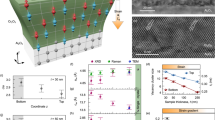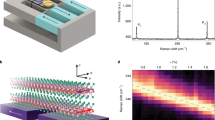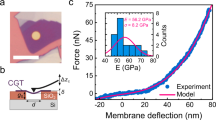Abstract
Magnetostriction, coupling between the mechanical and magnetic degrees of freedom, finds a variety of applications in magnetic actuation, transduction and sensing1,2. The discovery of two-dimensional layered magnetic materials3,4,5,6,7,8 presents a new platform to explore the magnetostriction effects in ultrathin solids. Here we demonstrate an exchange-driven magnetostriction effect in mechanical resonators made of two-dimensional antiferromagnetic CrI3. The mechanical resonance frequency is found to depend on the magnetic state of the material. We quantify the relative importance of the exchange and anisotropy magnetostriction by measuring the resonance frequency under a magnetic field parallel and perpendicular to the easy axis, respectively. Furthermore, we show efficient strain-tuning of the internal magnetic interactions in two-dimensional CrI3 as a result of inverse magnetostriction. Our results establish the basis for mechanical detection and control of magnetic states and magnetic phase transitions in two-dimensional layered materials.
This is a preview of subscription content, access via your institution
Access options
Access Nature and 54 other Nature Portfolio journals
Get Nature+, our best-value online-access subscription
$29.99 / 30 days
cancel any time
Subscribe to this journal
Receive 12 print issues and online access
$259.00 per year
only $21.58 per issue
Buy this article
- Purchase on Springer Link
- Instant access to full article PDF
Prices may be subject to local taxes which are calculated during checkout




Similar content being viewed by others
Data availability
The data that support the findings of this study are available within the paper and its Supplementary Information. Additional data are available from the corresponding authors upon request.
References
Joule, J. P. On the effects of magnetism upon the dimensions of iron and steel bars. Philos. Mag. 30, 76–87 (1847).
du Trémolet de Lacheisserie, E. Magnetostriction: Theory and Application of Magnetoelasticity (CRC Press, 1993).
Mak, K. F., Shan, J. & Ralph, D. C. Probing and controlling magnetic states in 2D layered magnetic materials. Nat. Rev. Phys. 1, 646–661 (2019).
Gong, C. et al. Discovery of intrinsic ferromagnetism in two-dimensional van der Waals crystals. Nature 546, 265–269 (2017).
Huang, B. et al. Layer-dependent ferromagnetism in a van der Waals crystal down to the monolayer limit. Nature 546, 270–273 (2017).
Gong, C. & Zhang, X. Two-dimensional magnetic crystals and emergent heterostructure devices. Science 363, eaav4450 (2019).
Gibertini, M., Koperski, M., Morpurgo, A. F. & Novoselov, K. S. Magnetic 2D materials and heterostructures. Nat. Nanotechnol. 14, 408–419 (2019).
Burch, K. S., Mandrus, D. & Park, J.-G. Magnetism in two-dimensional van der Waals materials. Nature 563, 47–52 (2018).
Song, T. et al. Giant tunneling magnetoresistance in spin-filter van der Waals heterostructures. Science 360, 1214–1218 (2018).
Klein, D. R. et al. Probing magnetism in 2D van der Waals crystalline insulators via electron tunneling. Science 360, 1218–1222 (2018).
Kim, H. H. et al. One million percent tunnel magnetoresistance in a magnetic van der Waals heterostructure. Nano Lett. 18, 4885–4890 (2018).
Wang, Z. et al. Very large tunneling magnetoresistance in layered magnetic semiconductor CrI3. Nat. Commun. 9, 2516 (2018).
Jiang, S., Shan, J. & Mak, K. F. Electric-field switching of two-dimensional van der Waals magnets. Nat. Mater. 17, 406–410 (2018).
Jiang, S., Li, L., Wang, Z., Mak, K. F. & Shan, J. Controlling magnetism in 2D CrI3 by electrostatic doping. Nat. Nanotechnol. 13, 549–553 (2018).
Huang, B. et al. Electrical control of 2D magnetism in bilayer CrI3. Nat. Nanotechnol. 13, 544–548 (2018).
Jin, C. et al. Imaging and control of critical spin fluctuations in two-dimensional magnets. Nat. Mater. https://doi.org/10.1038/s41563-020-0706-8 (2020).
Wang, Z. et al. Electric-field control of magnetism in a few-layered van der Waals ferromagnetic semiconductor. Nat. Nanotechnol. 13, 554–559 (2018).
Jiang, S., Li, L., Wang, Z., Shan, J. & Mak, K. F. Spin tunnel field-effect transistors based on two-dimensional van der Waals heterostructures. Nat. Electron. 2, 159–163 (2019).
Bunch, J. S. et al. Electromechanical Resonators from Graphene Sheets. Science 315, 490–493 (2007).
Chen, C. et al. Performance of monolayer graphene nanomechanical resonators with electrical readout. Nat. Nanotechnol. 4, 861–867 (2009).
Lee, J. et al. Electrically tunable single- and few-layer MoS2 nanoelectromechanical systems with broad dynamic range. Sci. Adv. 4, eaao6653 (2018).
Frisenda, R. et al. Biaxial strain tuning of the optical properties of single-layer transition metal dichalcogenides. npj 2D Mater. Appl. 1, 10 (2017).
Kim, H. H. et al. Magneto‐memristive switching in a 2D layer antiferromagnet. Adv. Mater. 32, 1905433 (2020).
Kittel, C. Model of exchange-inversion magnetization. Phys. Rev. 120, 335–342 (1960).
Swoboda, T. J., Cloud, W. H., Bither, T. A., Sadler, M. S. & Jarrett, H. S. Evidence for an antiferromagnetic-ferrimagnetic transition in Cr-modified Mn2Sb. Phys. Rev. Lett. 4, 509–511 (1960).
Levitin, R. Z. & Ponomarev, K. Magnetostriction of the metamagnetic iron-rhodium alloy. Sov. Phys. JETP 23.6, 984–985 (1966).
Hall, R. C. Single crystal anisotropy and magnetostriction constants of several ferromagnetic materials including alloys of NiFe, SiFe, AlFe, CoNi, and CoFe. J. Appl. Phys. 30, 816–819 (1959).
Šiškins, M. et al. Magnetic and electronic phase transitions probed by nanomechanical resonators. Nat. Commun. 11, 2698 (2020).
Storch, I. R. et al. Young’s modulus and thermal expansion of tensioned graphene membranes. Phys. Rev. B 98, 085408 (2018).
Shin, K.-H., Inoue, M. & Arai, K.-I. Strain sensitivity of highly magnetostrictive amorphous films for use in microstrain sensors. J. Appl. Phys. 85, 5465–5467 (1999).
Lee, C., Wei, X., Kysar, J. W. & Hone, J. Measurement of the elastic properties and intrinsic strength of monolayer graphene. Science 321, 385–388 (2008).
Liu, J., Sun, Q., Kawazoe, Y. & Jena, P. Exfoliating biocompatible ferromagnetic Cr-trihalide monolayers. Phys. Chem. Chem. Phys. 18, 8777–8784 (2016).
Zheng, F. et al. Tunable spin states in the two-dimensional magnet CrI3. Nanoscale 10, 14298–14303 (2018).
Zhang, R., Koutsos, V. & Cheung, R. Elastic properties of suspended multilayer WSe2. Appl. Phys. Lett. 108, 042104 (2016).
Acknowledgements
This work was primarily supported by the Air Force Office of Scientific Research under award FA9550-18-1-0480 (development of the experimental setup) and FA9550-19-1-0390 (optical characterizations). It was partially supported by the National Science Foundation under DMR-1807810 (modelling) and the Cornell Center for Materials Research with funding from the NSF MRSEC programme under DMR-1719875 (sample and device fabrication). This work was performed in part at Cornell NanoScale Facility, an NNCI member supported by NSF Grant NNCI-1542081. K.F.M. acknowledges support from a David and Lucille Packard Fellowship.
Author information
Authors and Affiliations
Contributions
S.J., K.F.M., J.S. and H.X. designed the study, discussed the results and co-wrote the manuscript. H.X. and S.J. developed the experimental setup and fabricated the devices. S.J. performed the bulk of the measurements and data analysis, assisted by H.X.
Corresponding authors
Ethics declarations
Competing interests
The authors declare no competing interests.
Additional information
Publisher’s note Springer Nature remains neutral with regard to jurisdictional claims in published maps and institutional affiliations.
Extended data
Extended Data Fig. 1 Mechanical resonance of 2D CrI3 under an out-of-plane magnetic field.
a,b, Field dependence of the amplitude (a) and linewidth (b) of the fundamental resonance of bilayer CrI3 resonator 1. The field dependence of the resonance frequency is shown in Fig. 2b. The red (blue) symbols correspond to the measurement for the positive (negative) field sweeping direction. c, Field dependence of the reflectance at 633 nm normalized by the reflectance at zero field.
Extended Data Fig. 2 Summary of six CrI3-resonators under an out-of-plane magnetic field.
For each device, the contour plot shows the vibration amplitude versus driving frequency under an out-of-plane field that sweeps from the top to the bottom value. The other two panels compare the field dependence of the resonance frequency (upper panel) and MCD (lower panel) of the membrane. The two colours denote the two field sweeping directions. a–c, Bilayer CrI3 resonator 1 (radius 2 μm), same as Fig. 2a–c. d–f, Bilayer CrI3 resonator 2 (radius 2 μm). g–i, Trilayer CrI3 resonator (radius 3 μm). j–l, Six-layer CrI3 resonator 1 (radius 3 μm), same as Fig. 2d–f. m–o, Six-layer CrI3 resonator 2 (radius 3 μm). p–r, Six-layer CrI3 resonator 3 (radius 3 μm). MCD of the trilayer resonator shows a ferromagnetic hysteresis loop centred at zero magnetic field (i), to which the mechanical resonance is not sensitive (h). The insets in i show the spin configuration of the system at given fields.
Extended Data Fig. 3 Summary of 2 CrI3-resonators under an in-plane magnetic field.
For each device, the contour plot shows the vibration amplitude versus driving frequency under an in-plane field that sweeps from the top to the bottom value. The other panel is the field dependence of the resonance frequency. The two colours denote the two field sweeping directions. a,b, Six-layer CrI3 resonator 1 (same as Fig. 3). c, d, Six-layer CrI3 resonator 3.
Extended Data Fig. 4 Inverse magnetostriction in six-layer CrI3 resonator 2.
a, Normalized MCD versus out-of-plane magnetic field that sweeps from 2.2 T to –2.2 T (only 2 T to 0.5 T and –0.5 T to –2 T is shown for clarity) at different values of Vg. b, c, Strain dependence of the two spin-flip transition fields (symbols). The error bars correspond to the spin-flip transition widths. The solid lines are linear fits.
Extended Data Fig. 5 Calibration of gate-induced strain and determination of resonator parameters.
a, Reflection contrast of bilayer CrI3 resonator 1 from 1.6–1.9 eV as a function of gate voltage. The main feature is a dip (around 1.75 eV at Vg = 0V), which corresponds to the fundamental exciton resonance of monolayer WSe2. The feature redshifts slightly with Vg up to about 40 V followed by a larger redshift with further increase of Vg. b, Representative spectra at selected Vgs. c, Exciton resonance energy extracted from a (left axis) and gate-induced strain calibrated from the exciton resonance energy (right axis) as a function of \(V_{\mathrm{g}}^4\) for Vg up to 39 V. The solid line is a linear fit. The built-in stress σ0 was determined from the slope.
Extended Data Fig. 6 2D CrI3 resonators under high out-of-plane fields.
Normalized vibration amplitude versus driving frequency under an out-of-plane magnetic field up to 5 T for six-layer CrI3 resonator 2. The resonance frequency, amplitude and linewidth basically do not change up to 5 T except at the spin-flip transitions.
Rights and permissions
About this article
Cite this article
Jiang, S., Xie, H., Shan, J. et al. Exchange magnetostriction in two-dimensional antiferromagnets. Nat. Mater. 19, 1295–1299 (2020). https://doi.org/10.1038/s41563-020-0712-x
Received:
Accepted:
Published:
Issue Date:
DOI: https://doi.org/10.1038/s41563-020-0712-x
This article is cited by
-
Metamaterial-based passive analog processor for wireless vibration sensing
Communications Engineering (2024)
-
Optimizing magnetoelastic properties by machine learning and high-throughput micromagnetic simulation
Rare Metals (2024)
-
Magnetic order in 2D antiferromagnets revealed by spontaneous anisotropic magnetostriction
Nature Communications (2023)
-
Spin-mediated shear oscillators in a van der Waals antiferromagnet
Nature (2023)
-
Low-pass filters based on van der Waals ferromagnets
Nature Electronics (2023)



